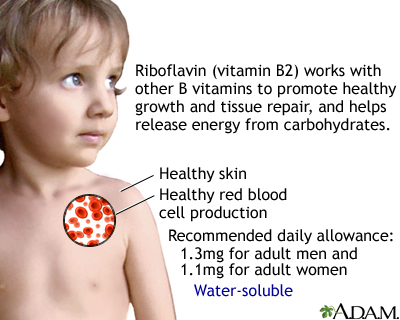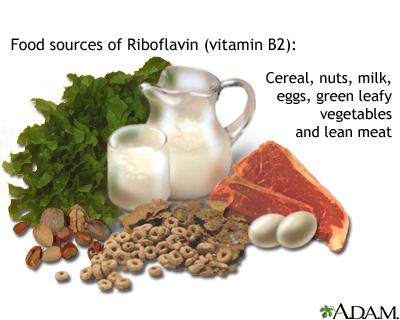Riboflavin
Vitamin B2
Riboflavin is a type of B vitamin. It is water soluble, which means it is not stored in the body. Water-soluble vitamins dissolve in water. Leftover amounts of the vitamin leave the body through the urine. The body keeps a small reserve of these vitamins. They have to be taken on a regular basis to maintain the reserve.
Images


I Would Like to Learn About:
Function
Riboflavin (vitamin B2) works with the other B vitamins. It is important for body growth. It helps in red blood cell production. It also aids in the release of energy from proteins.
Food Sources
The following foods provide riboflavin in the diet:
- Dairy products
- Eggs
- Green leafy vegetables
- Lean meats
- Organ meats, such as liver and kidneys
- Legumes
- Milk
- Nuts
Breads and cereals are often fortified with riboflavin. Fortified means the vitamin has been added to the food.
Riboflavin is destroyed by exposure to light. Foods with riboflavin should not be stored in clear containers that are exposed to light.
Side Effects
Lack of riboflavin is not common in the United States because this vitamin is plentiful in the food supply. Symptoms of a severe deficiency include:
- Anemia
- Mouth or lip sores
- Skin complaints
- Sore throat
- Swelling of mucous membranes
Because riboflavin is a water-soluble vitamin, leftover amounts leave the body through the urine. There is no known poisoning from riboflavin.
Recommendations
Recommendations for riboflavin, as well as other nutrients, are provided in the Dietary Reference Intakes (DRIs) developed by the Food and Nutrition Board at the National Academies of Sciences, Engineering, and Medicine. DRI is a term for a set of reference intakes that are used to plan and assess the nutrient intakes of healthy people. These values, which vary by age and sex, include:
Recommended Dietary Allowance (RDA): The average daily level of intake that is enough to meet the nutrient needs of nearly all (97% to 98%) healthy people. An RDA is an intake level based on scientific research evidence.
Adequate Intake (AI): This level is established when there is not enough scientific research evidence to develop an RDA. It is set at a level that is thought to ensure enough nutrition.
Dietary Reference Intakes for riboflavin:
Infants
- 0 to 6 months: 0.3* milligrams per day (mg/day)
- 7 to 12 months: 0.4* mg/day
*Adequate Intake (AI)
Children
- 1 to 3 years: 0.5 mg/day
- 4 to 8 years: 0.6 mg/day
- 9 to 13 years: 0.9 mg/day
Adolescents and adults
- Males age 14 and older: 1.3 mg/day
- Females age 14 to 18 years: 1.0 mg/day
- Females age 19 and older: 1.1 mg/day
- Pregnancy: 1.4 mg/day
- Lactation: 1.6 mg/day
The best way to get the daily requirement of essential vitamins is to eat a balanced diet that contains a variety of foods.
Related Information
CarbohydratesReferences
Maqbool A, Parks EP, Shaikhkhalil A, Panganiban J, Mitchell JA, Stallings VA. Nutritional requirements. In: Kliegman RM, St. Geme JW, Blum NJ, Shah SS, Tasker RC, Wilson KM, eds. Nelson Textbook of Pediatrics. 21st ed. Philadelphia, PA: Elsevier; 2020:chap 55.
Markell M, Siddiqi HA. Vitamins and trace elements. In: McPherson RA, Pincus MR, eds. Henry's Clinical Diagnosis and Management by Laboratory Methods. 24th ed. Philadelphia, PA: Elsevier; 2022:chap 27.
Mason JB, Booth SL. Vitamins, trace minerals, and other micronutrients. In: Goldman L, Schafer AI, eds. Goldman-Cecil Medicine. 26th ed. Philadelphia, PA: Elsevier; 2020:chap 205.
National Institutes of Health website. Riboflavin: fact sheet for health professionals. ods.od.nih.gov/factsheets/Riboflavin-HealthProfessional/. Updated May 11, 2022. Accessed February 21, 2023.
BACK TO TOPReview Date: 1/19/2023
Reviewed By: Stefania Manetti, RD/N, CDCES, RYT200, My Vita Sana LLC - Nourish and heal through food, San Jose, CA. Review provided by VeriMed Healthcare Network. Also reviewed by David C. Dugdale, MD, Medical Director, Brenda Conaway, Editorial Director, and the A.D.A.M. Editorial team.

Health Content Provider
06/01/2025
|
A.D.A.M., Inc. is accredited by URAC, for Health Content Provider (www.urac.org). URAC's accreditation program is an independent audit to verify that A.D.A.M. follows rigorous standards of quality and accountability. A.D.A.M. is among the first to achieve this important distinction for online health information and services. Learn more about A.D.A.M.'s editorial policy, editorial process and privacy policy. A.D.A.M. is also a founding member of Hi-Ethics. This site complied with the HONcode standard for trustworthy health information from 1995 to 2022, after which HON (Health On the Net, a not-for-profit organization that promoted transparent and reliable health information online) was discontinued. |
The information provided herein should not be used during any medical emergency or for the diagnosis or treatment of any medical condition. A licensed medical professional should be consulted for diagnosis and treatment of any and all medical conditions. Links to other sites are provided for information only -- they do not constitute endorsements of those other sites. © 1997- 2025 A.D.A.M., a business unit of Ebix, Inc. Any duplication or distribution of the information contained herein is strictly prohibited.
